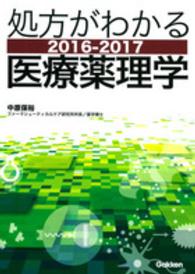- ホーム
- > 洋書
- > 英文書
- > Science / Mathematics
Full Description
IAU Symposium 285, New Horizons in Time-Domain Astronomy, gave a comprehensive overview of the status quo in 2011, exploring, astronomical variability at both Galactic and extragalactic distances. Several years later, IAU Symposium 339 witnessed a new level of activity and planning, with ambitious instruments that add a new dimension to some of those current in 2011 and ingenious methodology in the emerging field of astroinformatics. Major new instruments, whose output dwarfs those previously available, and analysis techniques that could not have been implemented until very recently, are being coupled with a broadening diversity in wavelengths. IAU S339 introduces the rich potential for new techniques for both analysis and communication, while covering the basic fundamentals such as data quality, standardization and archive access. Many early-career scientists are already central players in these projects: time-domain astronomy is the future and in their hands may it flourish and grow.
Contents
Part I. New Developments in the Last Five Years: 1. First Results of the SkyMapper Transient Survey; 2. The BVIT: from flare stars to the search for ET; 3. Gaia Alerts - an all-sky transient survey; 4. Probing galactic black holes with microlensing with Gaia and OGLE; 5. Fast radio bursts: from multi-beam receivers to interferometers; 6. The space-based photometry revolution; 7. The space-based photometry revolution; 8. Time-domain astroinformatics; Part II. Explosive Transients: 9. Fast radio transients: from pulsars to fast radio bursts; 10. Forming the progenitors of explosive stellar transients; 11. Discovering radio transients using 'triggered' and 'targeted' observations; 12. Multi-wavelength jet studies in cataclysmic variables and super luminous Supernovæ; 13. Early blue excess from the Type Ia Supernova 2017cbv; 14. Understanding the Galaxy; 15. The electromagnetic counterpart of the gravitational wave source GW170817; 16. Recent results from a high-resolution spectroscopic follow-up survey of classical Novæ; 17. A dust-enshrouded tidal disruption event in a luminous infared Galaxy; 18. The High-Cadence Transient Survey (HiTS): early supernova light-curves; Part III. Long-Term and Stellar Variability: 18. Progress of the Chinese plate-digitizing project; 19. Pulsation, rotation and flares in A stars; 20. The K2 RR Lyrae Survey; 21. Photometric variability of luminous blue variable stars on different time scales; 22. The Hubble Catalog of Variables (HCV); 23. Variability, pulsations and mass loss of evolved stars; 24. Measuring and decoding gravito-inertial modes in intermediate- and high-mass stars; 25. Strong shear and high-amplitude activity cycle in a metal-rich solar analogue; 26. Periodic variability on time-scales of decades to centuries in magnetic Ap stars: challenges and strategies; 27. Monitoring period variations of variable stars using precise photometric surveys; Part IV. High Energy: 28. Time-domain studies with Astrosat; 29. High-energy transients: thermonuclear (Type-I) X-Ray bursts; 30. Transient X-ray binaries in the Magellanic Clouds and Milky Way; 31. A new population of highly energetic nuclear transients; 32. The deeper wider faster programme: chasing the fastest bursts in the universe; 33. On the problem of standardization in time-domain photometry; 34. Discovery and opportunity in the X-Ray time domain; 35. X-Ray Transients observed with MAXI; 36. X-Ray transients in the SRG/eROSITA All-Sky Survey; 37. LMC X-4: different types of long-term variability; 38. The future of AGN variability studies; Part V. Can Our Techniques Meet the Challenges?: 39. Recognition of rare and peculiar temporal phenomena from LSST alert streams; 40. ANTARES: time-domain discovery in the Era of LSST; 41. Life beyond PTF; 42. Deep-learning the time domain; 43. Time-domain instrumentation at ESO; 44. The SALT transient programme; 45. OCTOCAM - a new workhorse instrument for transient follow-up at Gemini-S; 46. High-time-resolution astrophysics using the Thai 2.4-m Telescope with ULTRASPEC; 47. The Large Synoptic Survey Telescope: overview and update; 48. The Trans-Neptunian Automated Occultation Survey (TAOS II); 49. TESS science and follow-up in the Southern Hemisphere; 50. Unlocking the Universe with Astroinformatics; 51. Challenges and opportunities for machine learning in time-domain astronomy; 52. MeerLICHT: MeerKAT's Optical Eye; 53. Symposium 339 summary; Workshop reports; Poster papers; Poster summaries; Author index.







